

 Give a Cheer
Give a Cheer
The Forbidden City was the Chinese imperial palace from the Ming Dynasty to the end of the Qing Dynasty. It is located in the middle of Beijing, China, and now houses the Palace Museum. For almost 500 years, it served as the home of emperors and their households, as well as the ceremonial and political center of Chinese government.
Built in 1406 to 1420, the complex covers 7,800,000 sq ft. The palace complex exemplifies traditional Chinese palatial architecture. The Forbidden City covers an area of about 178 acres with a total floor space of approximately 1,600,000 square feet. It consists of 90 palaces and courtyards, 980 buildings and 8,704 rooms. To represent the supreme power of the emperor given from God, and the place where he lived being the center of the world, all the gates, palace and other structures of the Forbidden City were arranged about the south-north central axis of Beijing.
Construction lasted 15 years, and required more than a million workers. Materials used include whole logs of precious Phoebe zhennan wood found in the jungles of south-western China, and large blocks of marble from quarries near Beijing. The floors of major halls were paved with "golden bricks" specially baked paving bricks from Suzhou. It is the best preserved imperial palace in China and the largest ancient palatial structure in the world.
The Forbidden City was home to 24 emperors of the Ming (1368–1644) and Qing (1644–1911) Dynasties. In ancient times, the emperor claimed to be the son of Heaven, and therefore Heaven's supreme power was bestowed upon him. The emperors' residence on earth was built as a replica of the Purple Palace where God was thought to live in Heaven. Such a divine place was forbidden to ordinary people and that is why the Forbidden City is so named.
For security the Forbidden City is enclosed by a high city wall. At each corner of the Forbidden City, there stands a magnificent watchtower, which was heavily guarded in the past. Around the city there is a moat as the first line of defense.
It is recognized as one of the most important five palaces in the world (the other four are the Palace of Versailles in France, Buckingham Palace in the UK, the White House in the US and the Kremlin in Russia).
No products have been added to this project.
Thanks for spreading positivity!
May 02, 2012
April 22, 2012
April 20, 2012
April 16, 2012
April 16, 2012
April 16, 2012
April 14, 2012
April 14, 2012
April 14, 2012
April 14, 2012
April 14, 2012
April 14, 2012
April 14, 2012